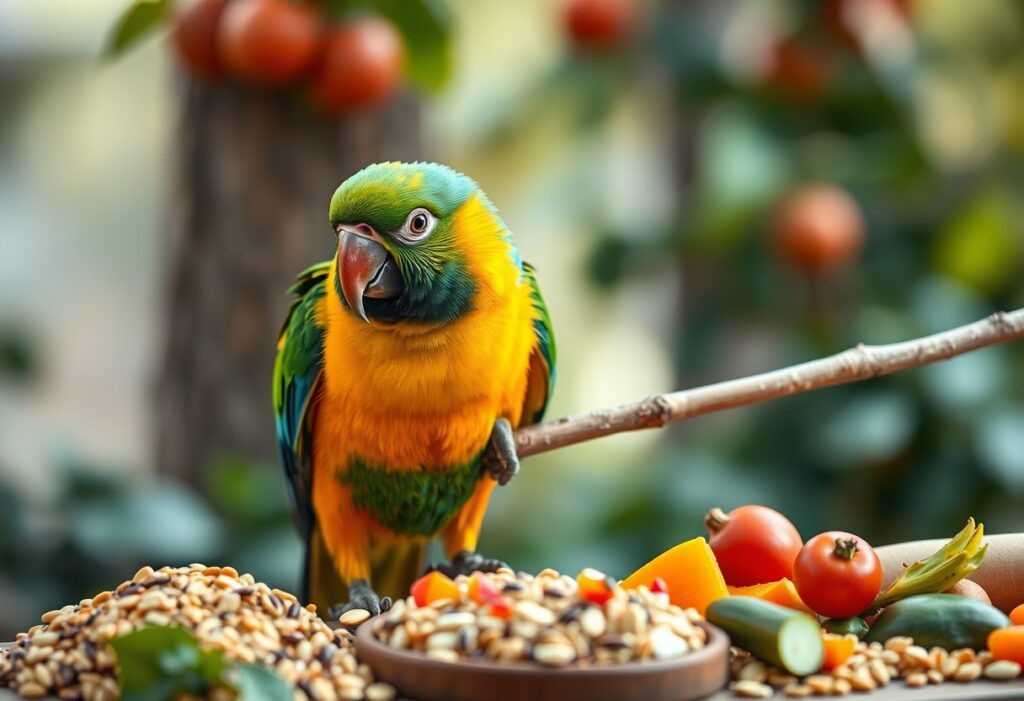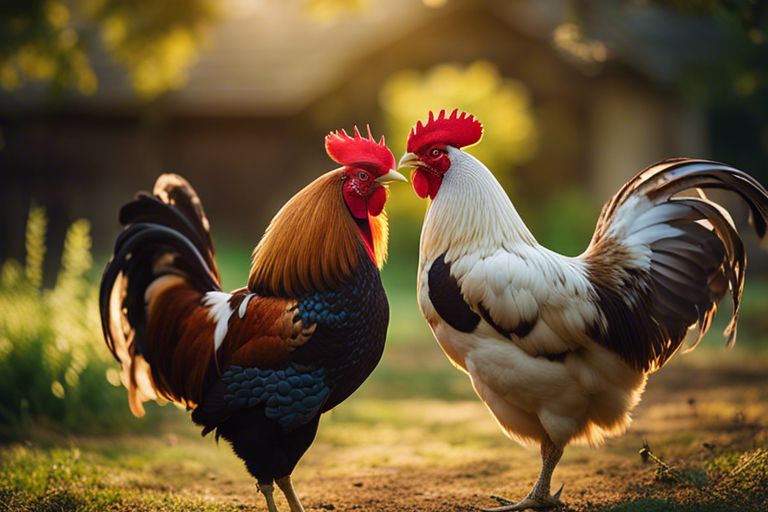Many aspects of a bird’s behavior hinge on its diet, influencing everything from mating rituals to territorial defense. Understanding how nutritional choices affect your feathered friends can help you create a better environment for them, whether in the wild or at home. Poor dietary habits can lead to health issues, affecting not only their physical well-being but also their social interactions and survival instincts. In this blog post, you’ll discover how you can positively impact bird behavior through informed dietary choices.
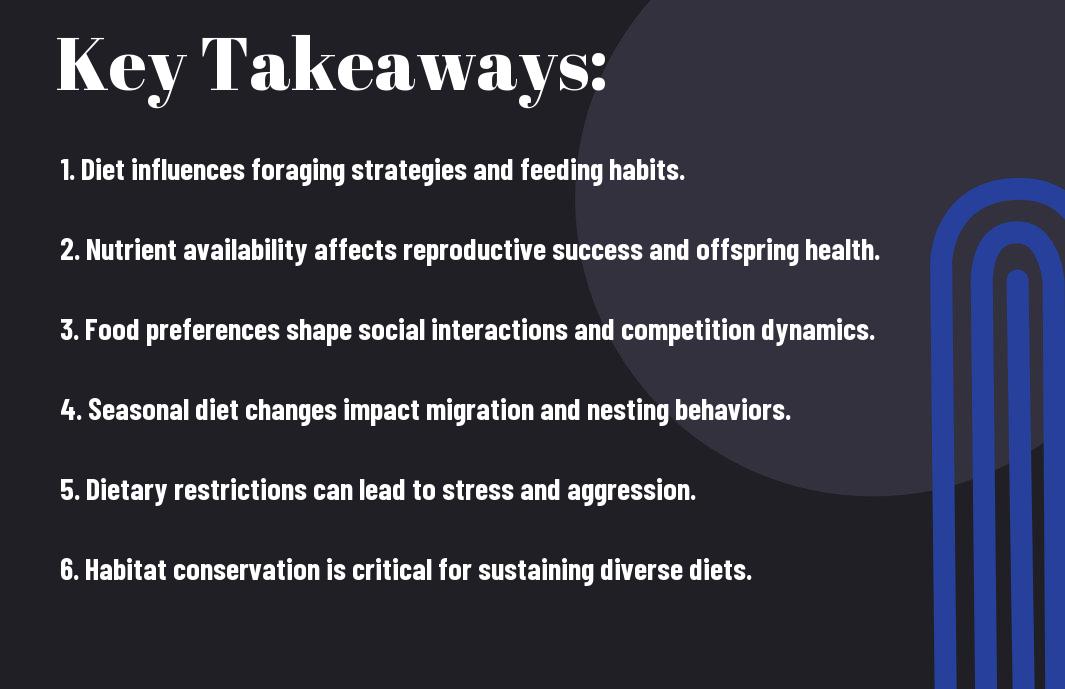
The Connection Between Diet and Behavior
To understand the intricate relationship between diet and behavior in birds, it is important to recognize that the food a bird consumes can significantly shape its daily activities, social interactions, and survival strategies. The dietary choices birds make not only affect their physical health but also their ability to find mates, establish territories, and adapt to environmental changes. As you probe into this fascinating connection, you’ll uncover how the preferences and necessities of a bird’s diet can reveal much about its behavioral tendencies.
Dietary Preferences
With the vast array of food sources available in the wild, birds exhibit a variety of dietary preferences that are often tied to their species, habitat, and even individual experiences. For instance, some birds may prefer insect larvae, while others might favor fruits or seeds, depending on what is most abundant in their environment. These preferences are driven not only by nutritional requirements but also by availability, leading to a selectivity in the foods they consume. As you observe different bird species, you may notice how their food choices align with their ecological roles—such as pollinators or seed dispersers—highlighting the importance of diet in maintaining ecological balance.
A bird’s dietary preferences can also influence its foraging behavior. For example, seed-eating birds often demonstrate different foraging tactics compared to nectar-feeding species, adapting to the specific challenges posed by their preferred food sources. Understanding these preferences can offer insights into how birds interact with their surroundings and compete with one another for resources.
Foraging Strategies
One fascinating aspect of avian behavior is the way birds develop a range of foraging strategies to locate and consume their preferred foods. The methods may include searching through leaf litter, probing tree bark, or even diving in water, depending on the bird’s ecological niche. Your observations of these foraging habits can highlight the remarkable adaptability of birds as a response to diet. For instance, some species are known to use tools to access food, which showcases an advanced level of problem-solving abilities that can be traced back to their dietary needs.
Preferences for food also dictate your interactions with the environment, where birds may exhibit more energy-efficient foraging techniques as they learn the locations of food sources or the behavior of competitors. This not only demonstrates the intelligent nature of birds but also reaffirms how their survival is closely intertwined with their dietary choices.
Social Interactions Influenced by Food
Food plays a crucial role in shaping social interactions among bird populations. As you observe different species, you will find that feeding habits can influence flocking behavior, mating rituals, and even territorial disputes. For example, birds that forage in groups often benefit from increased vigilance against predators, while others may engage in competitive feeding where dominant individuals gain access to the best resources. Such dynamics emphasize that while food can foster community among birds, it can also foster competition.
Another key aspect of social interactions revolving around food is the concept of food sharing and its role in strengthening social bonds. In many species, you might witness behaviors like mutual preening or vocalizations during feeding times that not only benefit individual birds nutritionally but also reinforce relationships within a flock. Ultimately, this interplay of diet and social behavior offers a rich tapestry of interactions that speaks to the complexity of avian life.
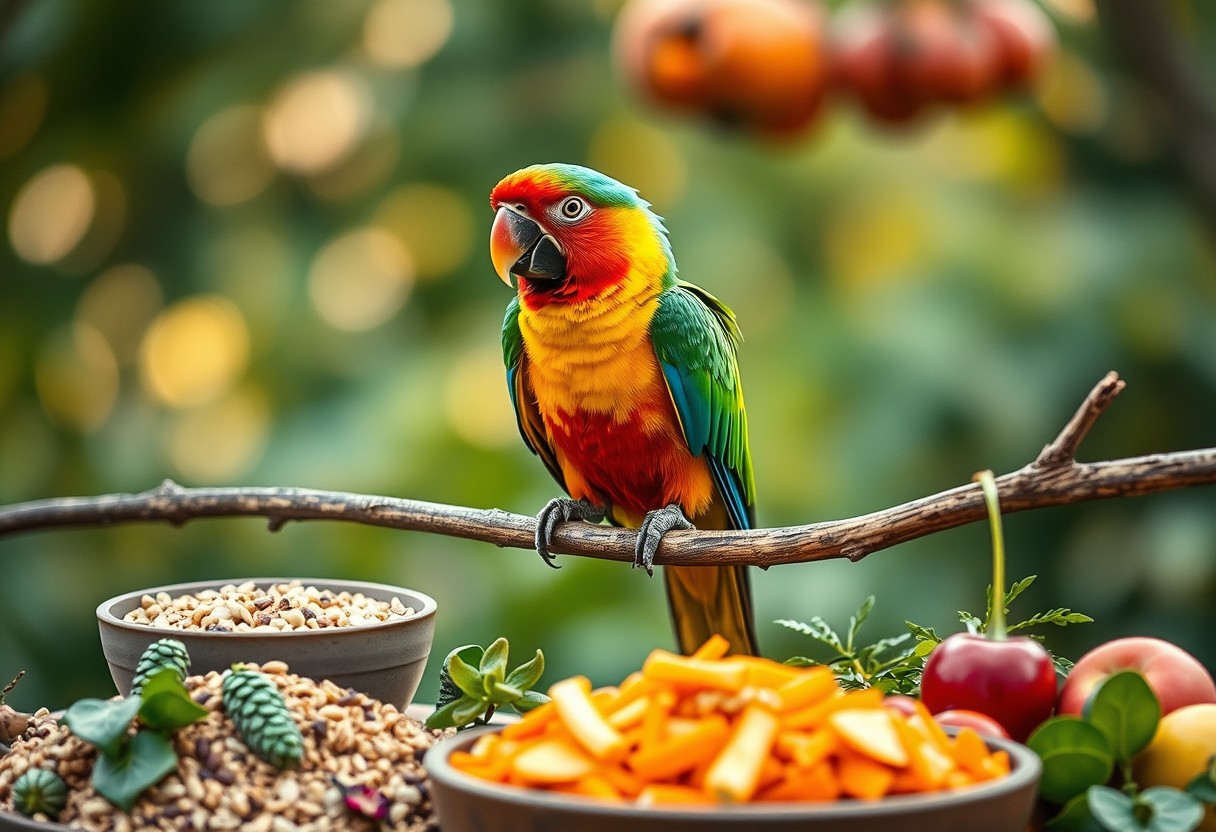
Nutritional Needs and Bird Activity
Some of the most crucial aspects of bird behavior are tightly linked to their nutritional needs. Understanding how a bird’s diet affects not only their physical health but also their daily activities can provide valuable insights into their overall behavior and habitat choices. Birds are highly variable in their dietary requirements depending on the species, their habitat, and the time of year, making your awareness of these factors crucial for supporting local bird populations.
Energy Requirements
An crucial aspect of a bird’s diet is its energy requirements. Birds have high metabolism rates, which means they need to consume a substantial amount of energy daily to support their activity levels. The amount of food a bird requires can vary from species to species, but it generally correlates with factors such as size, habitat, and the nature of their activity. For example, migratory birds need to consume even more calories, as they burn through stored energy during long flights.
While many birds feed on seeds, fruits, and insects, understanding the balance of carbohydrates, proteins, fats, vitamins, and minerals in their diet is critical. Providing birds with a variety of foods can help you ensure they meet their nutritional needs, thereby promoting healthy activity levels and behaviors.
Seasonal Dietary Changes
Changes in season often lead to adjustments in dietary habits for birds. During the warmer months, many species have access to an abundance of insects and fruits, which provide the necessary nutrients and energy for activities such as nesting and raising young. However, as autumn approaches and resources dwindle, birds may shift their diets to rely more heavily on seeds and other stored foods. This adaptability is crucial for survival and directly influences their behavior throughout the year.
Needs will fluctuate based on the environmental conditions and availability of food sources in your area. Understanding these shifts can help you better support local avian populations during these transitional periods. By providing food sources that align with the seasonal dietary requirements of birds, you can contribute significantly to their health and activity levels.
Breeding and Nutrition
Needs for proper nutrition become even more pronounced when it comes to breeding and raising young. During this critical period, birds require a diet rich in protein and calcium to support eggshell formation and healthy chick development. Failure to meet these nutritional demands can lead to decreased reproductive success and lower chick survivability.
It is vital to ensure that your feeding practices cater to these needs, especially during the breeding season. By providing a diverse array of high-quality foods, such as insects, seeds, and fruits, you can help bolster the health of breeding birds and enhance their chances of successfully raising their young.
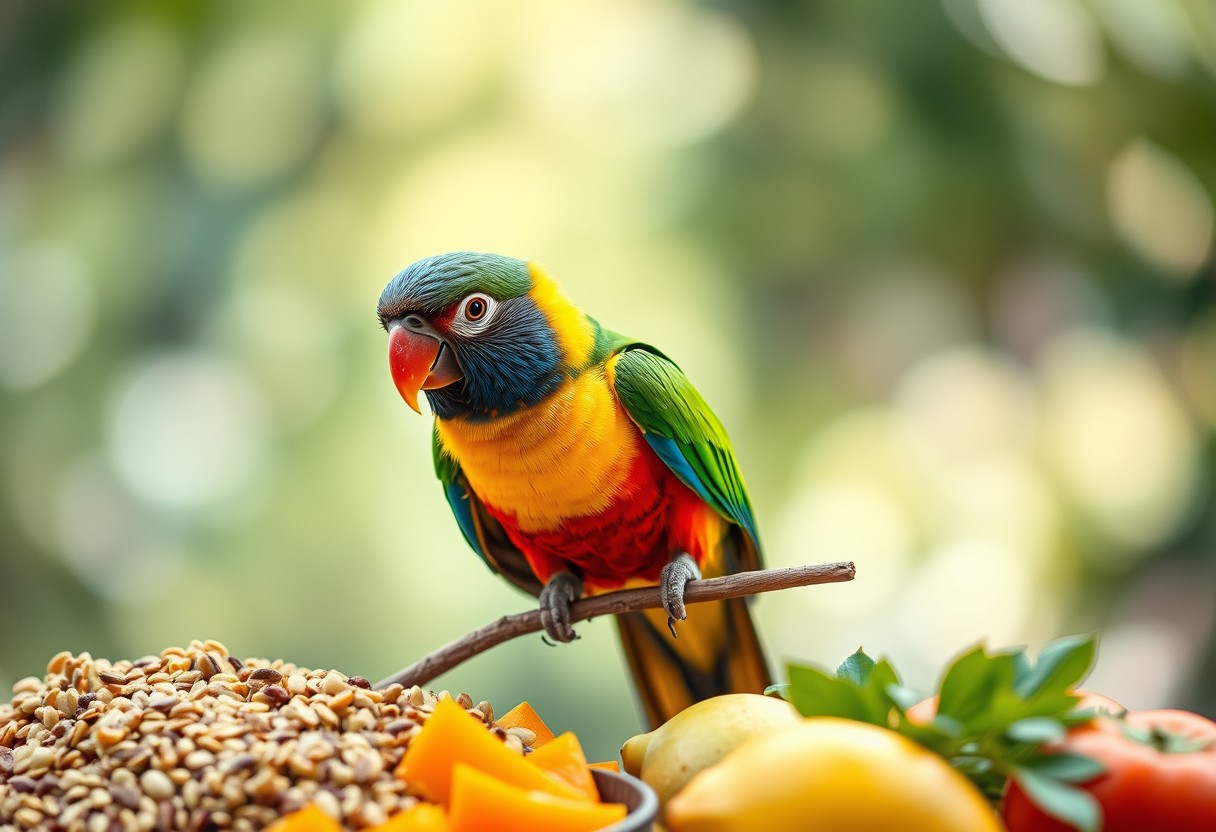
Impact of Food Availability on Behavior
After observing various bird species across different environments, it becomes clear that the availability of food significantly influences their behaviors. Access to diverse and abundant food supplies not only affects how birds engage with their surroundings but also plays a crucial role in crucial stages of their life, such as breeding, foraging strategies, and even social interactions. As a birdwatcher or an enthusiast, understanding these patterns can provide you valuable insights into the intricate lives of these avian creatures.
Habitat Selection
Availability of food resources directly impacts birds’ habitat selection. Species typically favor environments where they can reliably find their preferred foods, often leading them to choose habitats that might seem less appealing to other wildlife. For instance, a bird species that relies heavily on insects for sustenance may select wooded areas abundant in shrubs and trees that harbor insect populations over more open, barren terrains. This selective habitat choice ensures that they can meet their nutritional needs effectively.
Moreover, during periods of food scarcity, you may notice birds adapting their habitat selection dynamically. They might venture into less familiar territories or urban areas that offer alternative food sources, such as gardens, bird feeders, or refuse. This adaptability highlights the intrinsic link between food availability and the spatial behavior of birds, providing a fascinating aspect for you to explore during your observations.
Migration Patterns
With the changing seasons, food availability becomes a driving force behind migration patterns in many bird species. When certain areas experience dwindling food resources due to temperature fluctuations or environmental changes, birds may commence on long journeys to regions where food is plentiful. This migratory behavior serves as a survival strategy, allowing them to exploit seasonal abundance in different geographical areas.
Patterns of migration are not solely dictated by changes in food supply but are also influenced by breeding cycles. During breeding season, many birds will return to locations with rich food sources to ensure their young have adequate nutrition. For you, this means that understanding the timing and routes of these migrations can enhance your appreciation of the ecological factors shaping the bird populations you observe.
Aggression and Territoriality
Habitat features, particularly food distribution, play a significant role in determining aggression and territoriality among birds. In areas where food sources are abundant, you might witness heightened territorial behavior as birds establish and defend their claimed breeding or feeding territories against intruders. This behavior is crucial for maintaining their access to food and ensuring reproductive success.
Moreover, the intensity of aggression can vary depending on the availability and distribution of resources. In situations where food is scarce, birds might exhibit more aggressive behaviors toward each other to monopolize whatever food resources are available. Therefore, take note of how interactions among birds change throughout the seasons; observing these behaviors can offer you vital clues about their ecological dynamics.
Behavioral patterns regarding aggression and territoriality reinforce the importance of food resources in the avian world. Understanding how different species contend with competition over scarce resources sheds light on their social structures and survival strategies, allowing you to engage more deeply with the fascinating complexities of bird behavior.
Final Words
To wrap up, understanding the pivotal role that diet plays in bird behavior is crucial for anyone interested in avian biology and conservation. You should recognize that what birds eat can significantly affect their social interactions, mating rituals, foraging strategies, and overall habitat preferences. By taking into account your local environment and the availability of various food sources, you can better appreciate how dietary choices influence not only individual bird behaviors but also the dynamics of entire populations.
Your knowledge of the link between diet and behavior will empower you to make informed decisions, whether you are a birdwatcher, a conservationist, or a casual observer. As you continue to explore the rich tapestry of bird life, remember that fostering a diverse habitat and providing a balanced diet can help maintain healthy bird populations and promote positive behaviors. Ultimately, by appreciating the importance of nutrition in avian behavior, you contribute to more effective conservation efforts and a deeper connection with the avian world around you.
FAQ
Q: How does diet affect bird behavior and foraging habits?
A: Diet plays a crucial role in shaping bird behavior and foraging habits. Different bird species have evolved specific feeding strategies that align with their dietary preferences, whether they are seed-eaters, nectar-feeders, insectivores, or carnivores. For example, birds that primarily consume seeds, such as finches, exhibit behaviors like seed caching and selecting feeding locations based on the availability of preferred seeds. On the other hand, insectivorous birds may engage in more active foraging behaviors, such as fluttering, hovering, or probing bark and foliage to find insects. Additionally, the nutritional value of food can influence energy levels, mating displays, and territorial behaviors, highlighting the intricate connection between diet and bird behavior.
Q: Can changes in diet impact bird social interactions and hierarchy?
A: Yes, changes in diet can significantly impact bird social interactions and hierarchy within species. When food resources are scarce or significantly changed, competition for these resources can intensify, leading to alterations in social structures. For instance, during periods of food abundance, birds may exhibit more cohesive social behaviors, such as flocking. Conversely, during food shortages, aggressive behaviors may increase as individuals compete for limited resources. This competition can affect dominance hierarchies, with stronger or more aggressive individuals gaining access to better food sources, thereby influencing reproductive success and overall fitness of different birds within a group.
Q: How can human-induced changes to the environment affect the diets and behaviors of birds?
A: Human-induced changes such as urbanization, agriculture, and habitat destruction can significantly alter the diets and behaviors of birds. Land-use changes often lead to a reduction in natural food sources available to birds and can force them to adapt their diets to include anthropogenic food sources, such as discarded human food or crops. This dietary shift may lead to changes in foraging behavior, such as increased scavenging or reliance on feeders. Moreover, the introduction of invasive plant species can further complicate the food dynamics, often resulting in decreased diversity of native seeds and insects that birds rely on. These changes can negatively impact bird populations, influencing reproductive success, migratory patterns, and overall behavior as they adapt to the new environmental conditions.
